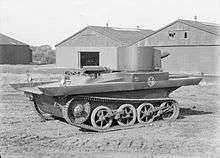Development of Chinese armoured forces (1927–45)
This article deals with the chronology and development of Chinese armoured forces from 1927 to 1945.
Introduction
The Chinese warlord Zhang Zuolin introduced tanks to China. Surprised during the Northern Expedition by Chiang Kai-shek's National Revolutionary Army, he bought several Renault FT tanks armed with 37 mm guns from France in 1927. It is uncertain how these tanks were used in combat, but they were eventually captured by the Japanese and the Chinese Nationalists. The tanks captured by the Japanese army were deployed in the Kwantung Army and later used during the Mukden Incident. The Nationalists in the meantime also bought 36 FTs. However, they saw no action but were used mainly for training.[1] Also about 6 or 10 Renault UE light armoured carriers armed with Browning MG were bought in France.
Additions


Influenced by the Japanese tank performance during the First Battle of Shanghai, the Chinese Nationalist government started the mechanisation of the army in 1933, buying 24 British Carden Loyd Mk VI tankettes. Later they bought about 20 Vickers 6-ton tanks between 1935 and 1936. They also bought some Vickers Amphibious Tanks, which were developed in 1932 and not used in the United Kingdom.[1]

Since 1930, the Nationalists had hired several German military advisers. They made the Nationalists purchase many European weapons through a German company with which the German advisers cooperated. The Nationalists bought Italian CV-33 and CV-35 tankettes, German Panzer I Ausf. A light tanks, and British 12-ton tanks. The exact name of the British 12-ton tank is unknown.[1]
With these newly purchased tanks the Nationalists organized three tank battalions in 1936. The 1st Battalion in Shanghai had 32 Vickers Amphibious tanks and some Vickers 6-ton tanks, and the 2nd Battalion also in Shanghai had 20 Vickers 6-ton tanks, 4 Carden Loyd tankettes and carriers. The 3rd Battalion in Nanking had 10 Panzer I Ausf. A tanks, 20 CV-33 tankettes and some SdKfz 221 and 222 armoured cars. When the Second Sino-Japanese War broke out in earnest, these battalions participated in the Second Battle of Shanghai and the Battle of Nanking and were more or less completely destroyed by the Japanese forces.[1]
In early 1938, the Japanese government demanded that the German government withdraw all German advisers from China. Given the closer relations between the two nations, Hitler agreed and soon after they left China.[1]

After the Germans left, the Soviet Union started to support the Nationalists. Soviet advisers and Soviet tanks arrived in China for the first time in March 1938.[2] The Soviet advisers organized a mechanised unit in China, the 200th Division, which consisted of one tank regiment and one motorised infantry regiment.[1] The tank regiment consisted of four tank battalions. Each tank battalion had three tank companies.[1] The tank regiments had approximately 200 armoured fighting vehicles (AFVs).[1] The Nationalist government bought 88 T-26 tanks and BA-10 and BA-20 armoured cars.[1] These AFVs and remaining German AFVs were deployed in the 200th Division and the division finally saw action in late 1938, when it inflicted a devastating defeat upon the Japanese army at the Battle of Kunlun Pass. This division then saw action in the Burma Theatre under Joseph Stilwell, to disastrous results.
Upon the American entry into the war in 1941, it began to supply China with AFVs which the Soviets were unable to provide. M3 Stuarts, M4 Shermans, and M18 Hellcats trickled in through Burma and formed part of the several well-equipped, well-trained armies that the Nationalists could deploy. These units were responsible for stopping numerous Japanese attacks during the later phases of the war(where is the evidence?).
See also
Notes
References
- L, Klemen (1999–2000). "Forgotten Campaign: The Dutch East Indies Campaign 1941-1942".